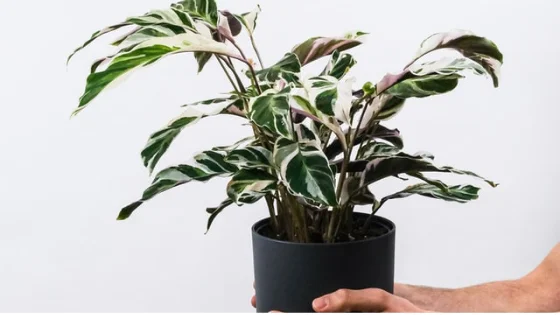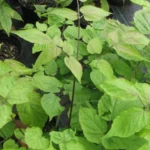Table of Contents
How To Care For Your Calathea White Fusion Plant
The calathea white fusion is the rare form of this kind of plant. It is a herbaceous perennial native to the tropical Americas and some parts of Africa.
Even though it is considered rare in its natural habitat, it makes a popular and wonderful houseplant because of the fullness of its leaves.
While the needs of the foliage are rather specific, once the caregiver knows what works, it becomes easier. Plus, the results are worth the effort.
In their place of origin, the white fusion plants are known for their bright flowers. However, as indoor plants, the foliage does not usually produce the flowers and are thus typically kept for their beautiful green, white, purple, and pink hues that run through the leaves and stems, that can grow up to 60cm (almost 24 inches) tall.
It is these colors and patterns that have brought on the common nicknames of zebra, peacock, and rattlesnake plants.
What Does Calathea White Fusion Require?
Care and Growth
The calathea white fusion care requirements are more specific than a lot of other houseplants. However, this has certainly not stopped them from becoming popular in the household, and with its appearance, it is not difficult to see why.
To ensure that the plant becomes as healthy and vibrant as possible, the following needs must be taken care of:
Light
The lighting is one of the most specific and crucial aspects of the development of your calathea white fusion. Filtered bright light works best. Direct light that is too bright will cause the markings to fade and will create wilting leaves.
A light that is not bright enough will result in the plant not developing properly. With regards to direction, North, West, or East facing windows are recommended.
A southern facing window is typically too bright. However, if this is necessary, a sheer curtain may be put over the window to act as a protective layer.
Temperature
While temperatures as low as 15 degrees Celsius (59 degrees Fahrenheit) can sustain their existence, consistent warmer heat of between 18-23 degrees Celsius (64-73 degrees Fahrenheit) works best for the calathea white fusion.
Sudden temperature changes can harm these plants. Lowering the heat while not at home or during the night for sleeping should be done gradually and in small increments to prevent any temperature shock to the plant.
Humidity
Regular household humidity can work for your calathea white fusion even though they tend to appreciate slightly higher levels. In drier air, humidifiers are often recommended to keep the air and soil moist.
Mist sprays may also be used to add moisture to the air. Well-ventilated areas with this higher level of humidity are even better.
Water
The soil must be kept moist while overwatering is to be prevented. Waterlogged soil may cause damage to the plant as well as the development of disease. To prevent this, water should only be added when the top layer of soil is dry.
Filtered tap water may be used, although some professionals prefer the use of distilled or rainwater because any toxicity in the town water supply could harm the plant.
Soil
Potting mixes that are listed for African violets are the same that can be used for these houseplants. For anyone creating their own mix, it should be an airy form of standard potting soil along with perlite, orchard bark, and peat.
Fertilizer
A weak nitrogen-rich liquid fertilizer designed for foliage-dense plants is recommended. The food can be added each month during the spring and summer. Fertilizing isn’t necessary during the fall and winter months.
Extra tips for Calathea White Fusion
Pests and Diseases
fungus gnat
Possibly the most common pest for this calathea is the fungus gnat. This creature does not cause a lot of damage, but they are rather unsightly.
They can be eliminated by using chemical insect sprays or all-natural neem oil. This oil also acts as a repellent against future infestations of fungus gnats and other pests.
Spider mites
Spider mites are another pest that can cause issues for this foliage, and they can create a lot of damage. Careful inspection of the leaves and stems may help with the discovery.
Some of the first signs include a light dusty look on the underside of the leaves made by the spider webs. If the infestation continues, there may be discolored and dying leaves appearing in the affected locations.
There are certain insecticides and insecticidal soaps readily available to eliminate these infestations.
Root rot
Root rot is a disease commonly caused by overwatering or letting the roots sit in waterlogged soil. Using a pot with an excellent drainage system helps prevent root rot, as does placing the plant in a well-ventilated area.
When root rot is present, part of the remedy is repotting the plant in fresh soil and ensuring that the pot has the proper drainage system in place. A fungicide suitable for this kind of plant may be required.
Holes
While not a disease as such, at times, holes may form in the leaves of the foliage. This is typically caused by using too much fertilizer in the soil or not enough moisture in the air.
To remedy the problem, less fertilizer should be used and more moisture added to the air.
Pruning
Curled or brown leaves may be cut from the stalk, where they meet at the joint, without causing any harm to the plant. This should be done as soon as they are spotted to keep the foliage healthy. Brown edges on leaves can be trimmed with sharp scissors.
Propagation
Propagation can be done through root division. The best time for this is during the repotting. There is often a natural separation of the roots, where they can be gently divided. Roots can be planted in new pots filled with fresh soil.
They should be kept warm and moist, and placed in a humid area with reduced lighting. Growth tends to start within two to four weeks of planting.
Every few years, the plant can be repotted, separating roots again if desired. Because the roots are so fragile, repotting and division must be attempted with care.
Propagation is possible through the use of seed as well. However, true calathea white fusion seeds are often difficult to find.
Toxicity
The calathea white fusion is not toxic to people or animals.
Photo by Severin Candrian on Unsplash



